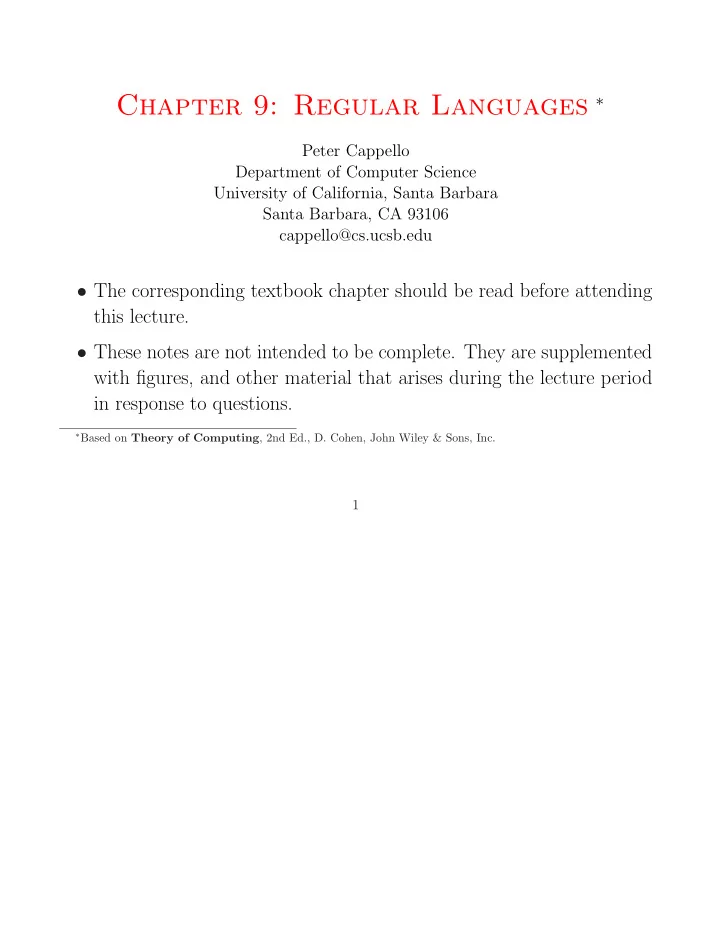

Chapter 9: Regular Languages ∗ Peter Cappello Department of Computer Science University of California, Santa Barbara Santa Barbara, CA 93106 cappello@cs.ucsb.edu • The corresponding textbook chapter should be read before attending this lecture. • These notes are not intended to be complete. They are supplemented with figures, and other material that arises during the lecture period in response to questions. ∗ Based on Theory of Computing , 2nd Ed., D. Cohen, John Wiley & Sons, Inc. 1
Closure Properties Definition: The language denoted by a regular expression is a regular language . 2
Theorem: If L 1 and L 2 are regular languages, then L 1 ∪ L 2 , L 1 L 2 , and L ∗ 1 are regular languages. Proof (by regular expression): 1. Since L 1 and L 2 are regular languages, each is denoted by some regular expression, say r 1 and r 2 , respectively. 2. Given regular expressions r 1 and r 2 , r 1 + r 2 , r 1 r 2 , and r 1 ∗ are regular expressions, by the inductive rules for forming regular ex- pressions. 3. The languages denoted by these regular expressions are L 1 ∪ L 2 , L 1 L 2 , and L ∗ 1 , respectively. 4. Thus, these languages are regular. 3
Proof (by machine): 1. Since L 1 and L 2 are regular languages, there exist TGs that accept them, say TG 1 and TG 2 , respectively. 2. Assume, without loss of generality, that each has a single initial state and a single final state. 3. Given these TGs, it is easy to construct TGs that accept L 1 ∪ L 2 , L 1 L 2 , and L ∗ 1 . Produce on blackboard. 4. Thus, these languages are regular. 4
Example Let Σ = { a, b } . • Let L 1 = a ( a + b ) ∗ a + b ( a + b ) ∗ b = { the set of all strings of length ≥ 2 that begin and end with the same letter. } • Let L 2 = ( a + b ) ∗ aba ( a + b ) ∗ = { the set of all strings that contain “ aba ” as a substring. } Then: • L 1 ∪ L 2 = ( a ( a + b ) ∗ a + b ( a + b ) ∗ b ) + (( a + b ) ∗ aba ( a + b ) ∗ ). • L 1 L 2 = ( a ( a + b ) ∗ a + b ( a + b ) ∗ b )(( a + b ) ∗ aba ( a + b ) ∗ ). • L ∗ 1 = ( a ( a + b ) ∗ a + b ( a + b ) ∗ b ) ∗ . Produce machine compositions on the blackboard. 5
Complements and Intersections Theorem: If L is a regular language, L is regular. Proof: 1. Since L is regular, there is an FA, A , that accepts it. 2. Create a new FA, A , which is the same as A , except F A = Q A − F A . 3. Word w is accepted by A if and only if it is rejected by A . 4. Since A is an FA, L ( A ) is regular. Apply the construction on even − odd , the set of strings with an even number of a ’s and an odd number of b ’s. 6
Theorem: If L 1 and L 2 are a regular languages, L 1 ∩ L 2 is regular. Proof: By DeMorgan’s law, L 1 ∩ L 2 = L 1 ∪ L 2 , a regular language. Illustrate DeMorgan’s law with a Venn Diagram. 7
Proof: (machine-based) Replicate the FA construction for the union of 2 regular languages, but final states are those where both component states are final in the given machines. Thus, a word is accepted by the constructed FA if and only if it is accepted by both given finite automata. Illustrate on the set of words that begin with a and end with b . 8
Recommend
More recommend